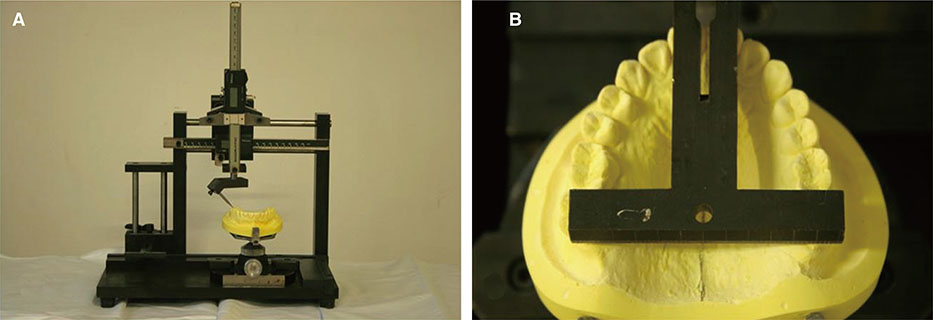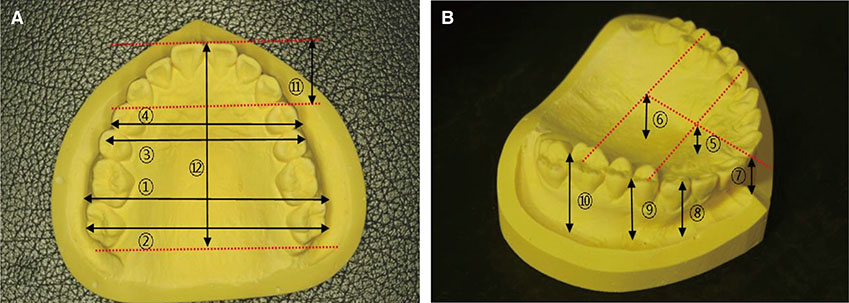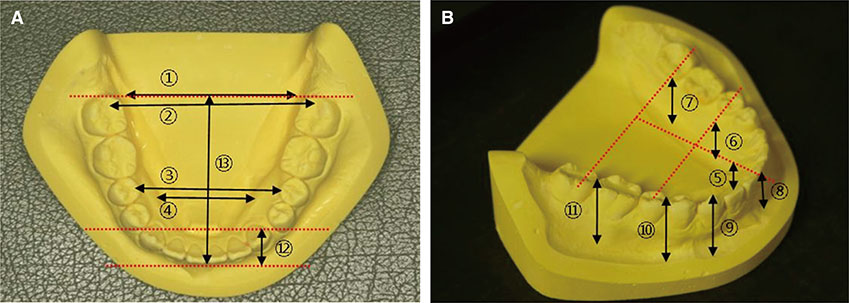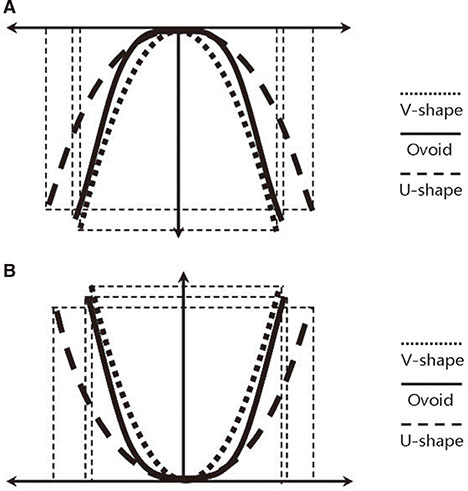J Adv Prosthodont.
2017 Oct;9(5):321-327. 10.4047/jap.2017.9.5.321.
Analysis of dimensions and shapes of maxillary and mandibular dental arch in Korean young adults
- Affiliations
-
- 1Department of Biomaterials and Prosthodontics, Kyung Hee University Hospital at Gangdong, School of Dentistry, Kyung Hee University, Seoul, Republic of Korea. sbykmw@yahoo.co.kr, hswhsh@khu.ac.kr
- 2Department of Prosthodontics, Graduate School of Dentistry, Kyung Hee University, Seoul, Republic of Korea.
- KMID: 2393216
- DOI: http://doi.org/10.4047/jap.2017.9.5.321
Abstract
- PURPOSE
The aim of this study was to investigate dental arch dimensions and to classify arch shape in Korean young adults.
MATERIALS AND METHODS
The sample included 50 Koreans with age ranging from 24 to 32 years. Maxillary and mandibular casts were fabricated using irreversible hydrocolloid and type III dental stones. Incisor-canine distance, incisor-1(st) molar distance, incisor-2(nd) molar distance, intercanine distance, inter-1(st) molar distance, and inter-2(nd) molar distance in both the maxillary and mandibular arch were measured using a three-dimensional measuring device. The dental arch was classified into three groups using five ratios from the measured values by the K-means clustering method. The data were analyzed with one-way analysis of variance.
RESULTS
Arch lengths (IM2D, incisal-2(nd) molar distance) were 44.13 mm in the maxilla and 40.40 mm in the mandible. Arch widths (M2W, inter 2(nd) molar width) were 64.12 mm in the maxilla and 56.37 mm in the mandible. Distribution of the dental arch form was mostly ovoid shape (maxilla 52% and mandible 56%), followed by the V-shape and the U-shape. The arch width for the U-shape was broader than for the other forms.
CONCLUSION
This study establishes new reference data for dental arch dimensions for young Korean adults. The most common arch form is the ovoid type in the maxilla and mandible of Koreans. Clinicians should be aware of these references and classify arch type before and during their dental treatment for effective and harmonized results in Koreans.
Figure
Reference
-
1. Smith SS, Buschang PH, Watanabe E. Interarch tooth size relationships of 3 populations: “does Bolton’s analysis apply?”. Am J Orthod Dentofacial Orthop. 2000; 117:169–174.2. Al-Khateeb SN, Abu Alhaija ES. Tooth size discrepancies and arch parameters among different malocclusions in a Jordanian sample. Angle Orthod. 2006; 76:459–465.3. Ferrario VF, Sforza C, Colombo A, Carvajal R, Duncan V, Palomino H. Dental arch size in healthy human permanent dentitions: ethnic differences as assessed by discriminant analysis. Int J Adult Orthodon Orthognath Surg. 1999; 14:153–162.4. Dalidjan M, Sampson W, Townsend G. Prediction of dental arch development: an assessment of Pont's Index in three human populations. Am J Orthod Dentofacial Orthop. 1995; 107:465–475.5. Hassanali J, Pokhariyal GP. Anterior tooth relations in Kenyan Africans. Arch Oral Biol. 1993; 38:337–342.6. Merz ML, Isaacson RJ, Germane N, Rubenstein LK. Tooth diameters and arch perimeters in a black and a white population. Am J Orthod Dentofacial Orthop. 1991; 100:53–58.7. Hattab FN, al-Khateeb S, Sultan I. Mesiodistal crown diameters of permanent teeth in Jordanians. Arch Oral Biol. 1996; 41:641–645.8. Nummikoski P, Prihoda T, Langlais RP, McDavid WD, Welander U, Tronje G. Dental and mandibular arch widths in three ethnic groups in Texas: a radiographic study. Oral Surg Oral Med Oral Pathol. 1988; 65:609–617.9. Townsend GC, Brown T. Heritability of permanent tooth size. Am J Phys Anthropol. 1978; 49:497–504.10. Garn SM, Lewis AB, Kerewsky RS. Sex difference in tooth size. J Dent Res. 1964; 43:306.11. Jacobson A. The craniofacial skeletal pattern of the South African Negro. Am J Orthod. 1978; 73:681–691.12. Chan GK. A cephalometric appraisal of the Chinese (Cantonese). Am J Orthod. 1972; 61:279–285.13. Gresham H. A comparison of skeletal and denture patterns in Australian and North American children. Aust Dent J. 1965; 10:1–5.14. Kim SH, Chung HJ. The relationship between clinical crown form and gingival feature in upper anterior region. J Korean Acad Periodontol. 2005; 35:761–776.15. Nam JH, Lee KS. An analysis about mandibular dental arch on normal dentition of Koreans. Korean J Orthod. 1996; 26:535–564.16. Oh YR, Lee SB, Park NS, Choi DG. An analysis about maxillary dental arch shape on adult Koreans. J Korean Acad Prosthodont. 1995; 33:753–768.17. Song DS, Jin TH, Dong JG. A study of the fitness of stock tray in Korean adults. J Korean Acad Prosthodont. 1989; 27:131–141.18. Kwon YC, Sung JO, Kwon OW, Sung JH. The dental arch form in normal occlusion. Korean J Orthod. 1989; 19:95–106.19. Yu JD. An anthropological analysis about dental arch on Koreans. J Korean Dent Acad. 1975; 13:533–538.20. Chung HI. A study on the normal dental arch form of Korean adult. Korean J Orthod. 1972; 3:7–13.21. Cho JH, Lee KS. A study of dental arch form in normal occlusion. Korean J Orthod. 1984; 14:249–262.22. Lee YC, Park YC. A study on the dental arch by occlusogram in normal occlusion. Korean J Orthod. 1987; 17:279–288.23. Kim IH, Choi DG. A study of mandibular dental arch of Korean adults. J Korean Acad Prosthodont. 1998; 36:166–182.24. Jun S, Ha K, Chung S, Joung H. Meat and milk intake in the rice-based Korean diet: impact on cancer and metabolic syndrome. Proc Nutr Soc. 2016; 75:374–384.25. Cho Y, Shin MJ, Chung HK. Effects of diet modification on meal quality and quality of life in korean diabetic patients: data from Korea national health and nutrition examination survey (2007–2011). Clin Nutr Res. 2014; 3:106–114.26. Lee M, Chae SW, Cha YS, Cho MS, Oh HY, Kim MK. Development of a Korean Diet Score (KDS) and its application assessing adherence to Korean healthy diet based on the Korean Food Guide Wheels. Nutr Res Pract. 2013; 7:49–58.27. BeGole EA. Application of the cubic spline function in the description of dental arch form. J Dent Res. 1980; 59:1549–1556.28. Marcotte MR. The use of the occlusogram in planning orthodontic treatment. Am J Orthod. 1976; 69:655–667.29. White LW. The clinical use of occlusograms. J Clin Orthod. 1982; 16:92–103.30. Lee KJ, Trang VT, Bayome M, Park JH, Kim Y, Kook YA. Comparison of mandibular arch forms of Korean and Vietnamese patients by using facial axis points on three-dimensional models. Korean J Orthod. 2013; 43:288–293.
- Full Text Links
- Actions
-
Cited
- CITED
-
- Close
- Share
- Similar articles
-
- Comparison of arch form between ethnic Malays and Malaysian Aborigines in Peninsular Malaysia
- Expansion of the mandibular arch using a trombone appliance
- Model analysis in orthodontic treatment changes of the maxillary dental arch
- The new approach to maxillary and mandibular anterior dental arch forms : In Korean normal occlusion models
- A longitudinal study on the developmental changes of dental arch width and length







